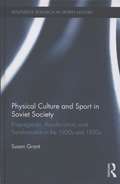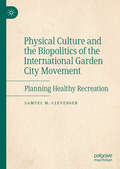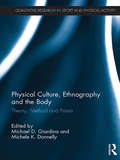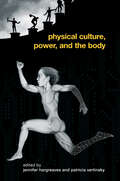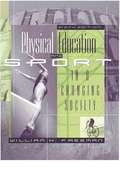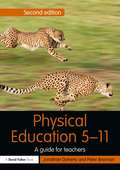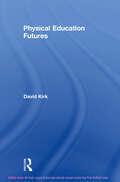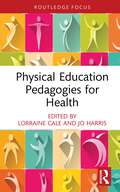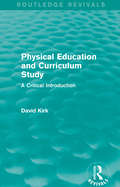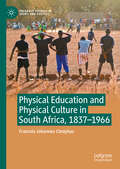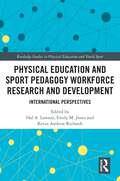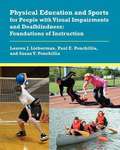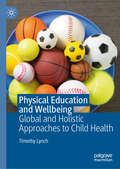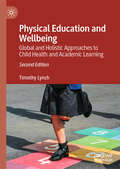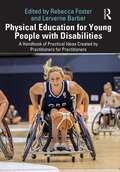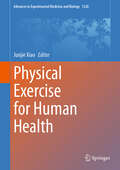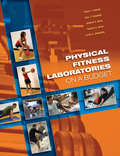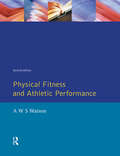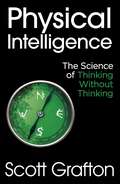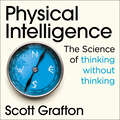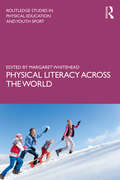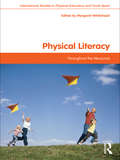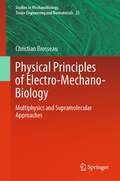- Table View
- List View
Physical Culture and Sport in Soviet Society: Propaganda, Acculturation, and Transformation in the 1920s and 1930s
by Susan GrantFrom its very inception the Soviet state valued the merits and benefits of physical culture, which included not only sport but also health, hygiene, education, labour and defence. Physical culture propaganda was directed at the Soviet population, and even more particularly at young people, women and peasants, with the aim of transforming them into ideal citizens. By using physical culture and sport to assess social, cultural and political developments within the Soviet Union, this book provides a new addition to the historiography of the 1920s and 1930s as well as to general sports history studies.
Physical Culture and Sport in Soviet Society: Propaganda, Acculturation, and Transformation in the 1920s and 1930s (Routledge Research in Sports History Series #2)
by Susan GrantFrom its very inception the Soviet state valued the merits and benefits of physical culture, which included not only sport but also health, hygiene, education, labor and defense. Physical culture propaganda was directed at the Soviet population, and even more particularly at young people, women and peasants, with the aim of transforming them into ideal citizens. By using physical culture and sport to assess social, cultural and political developments within the Soviet Union, this book provides a new addition to the historiography of the 1920s and 1930s as well as to general sports history studies.
Physical Culture and the Biopolitics of the International Garden City Movement: Planning Healthy Recreation
by Samuel M. ClevengerThis book revisits the history of the international garden city town planning movement in the early twentieth century, focusing on the significance of various forms of 'physical culture' - sport, recreation, leisure, and other active body practices - within garden city planning discourse and the development of some of the first garden city communities in the United Kingdom and United States.
Physical Culture, Ethnography and the Body: Theory, Method and Praxis (Qualitative Research in Sport and Physical Activity)
by Michael D. Giardina Michele K. DonnellyThe corporeal turn toward critical, empirically grounded studies of the body is transforming the way we research physical culture, most evidently in the study of sport. This book brings together original insights on contemporary physical culture from key figures working in a variety of disciplines, offering a wealth of different theoretical and philosophical ways of engaging with the body while never losing site of the material form of the research act itself. Contributors spanning the disciplines of sociology, anthropology, communications, and sport studies highlight conceptual, methodological, and empirical approaches to the body that include observant-participation, feminist ethnography, autoethnography, physical cultural studies, and phenomenology. They provide vivid case studies of embodied research on topics including basketball, boxing, cycling, dance, fashion modelling and virtual gaming. This international collection not only reflects on the most important recent developments in embodied research practices, but also looks forward to the continuing importance of the body as a focus for research and the possibilities this presents for studies of the active, moving body in physical culture and beyond. Physical Culture, Ethnography and the Body: Theory, method and praxis is fascinating reading for all those interested in physical cultural studies, the sociology of sport and leisure, physical education or the body.
Physical Culture, Power, and the Body (Routledge Critical Studies in Sport)
by Patricia Vertinsky Jennifer HargreavesDuring the past decade, there has been an outpouring of books on 'the body' in society, but none has focused as specifically on physical culture - that is, cultural practices such as sport and dance within which the moving physical body is central. Questions are raised about the character of the body, specifically the relation between the ‘natural’ body, the ‘constructed’ body and the ‘alien’ or ‘virtual’ body. The themes of the book are wide in scope, including: physical culture and the fascist body sport and the racialised body sport medicine, health and the culture of risk the female Muslim sporting body, power, and politics experiencing the disabled sporting body embodied exhibitions of striptease and sport the social logic of sparring sport, girls and the neoliberal body. Physical Culture, Power, and the Body aims to break down disciplinary boundaries in its theoretical approaches and its readership. The author’s muli-disciplinary backgrounds, demonstrate the widespread topicality of physical culture and the body.
Physical Education & Sport in a Changing World
by William H. FreemanThis sixth edition of Society examines the developing subdisciplines and interests in the broad field of physical education, sport, exercise science, and kinesiology.
Physical Education 5-11: A guide for teachers (Primary 5-11 Series)
by Jonathan Doherty Peter BrennanPhysical Education 5-11 is about lighting or relighting a fire in all those who have the privilege and the responsibility of teaching children physical education in Primary schools today. It is written at a time of great change: a revised Primary curriculum; an increased drive to raise achievement and potentially a narrowing of curricular scope in favour of literacy and numeracy. It is little wonder that teachers are looking for certainty and answers to questions such as:- What do I teach in PE? What do I need to know about children’s development? What does good teaching look like in PE? How can I assess such a practical subject effectively? ? This new and updated edition provides answers to those questions, covers issues in Physical Education and provides a wealth of practical advice on teaching across the stages of the new 2014 curriculum. Drawing upon the author’s experiences as a teacher, coach, lecturer and adviser, it delivers a justification for PE as an essential element in the Primary curriculum, imbues a theory into practice approach that provides readers with clarity, instils confidence and offers a licence to teach all practical aspects of PE effectively and creatively underpinned by knowledge of children’s development, their learning and the critical professional issues in PE today. This book is the essential companion to inform and inspire students and practising teachers in this most dynamic and exciting of subjects!
Physical Education Futures (Routledge Studies in Physical Education and Youth Sport)
by David KirkCan we imagine a future in which physical education in schools no longer exists? In this controversial and powerful meditation on physical education, David Kirk argues that a number of different futures are possible. Kirk argues that multi-activity, sport-based forms of physical education have been dominant in schools since the mid-twentieth century and that they have been highly resistant to change. The practice of physical education has focused on the transmission of de-contextualised sport-techniques to large classes of children who possess a range of interests and abilities, where learning rarely moves beyond introductory levels. Meanwhile, the academicization of physical education teacher education since the 1970s has left teachers less well prepared to teach this programme than they were previously, suggesting that the futures of school physical education and physical education teacher education are intertwined. Kirk explores three future scenarios for physical education, arguing that the most likely short-term future is ‘more of the same’. He makes an impassioned call for radical reform in the longer-term, arguing that without it physical education faces extinction. No other book makes such bold use of history to interrogate the present and future configurations of the discipline, nor offers such a wide-ranging critique of physical culture and school physical education. This book is essential reading for all serious students and scholars of physical education and the history and theory of education.
Physical Education Pedagogies for Health (Routledge Focus on Sport Pedagogy)
by Lorraine Cale Jo HarrisThis book focuses on health within physical education (PE) and specifically on PE pedagogies for health. It gives practitioners and students the knowledge, understanding, skills and confidence to employ effective health pedagogies and practices in their work, and to promote healthy, active lifestyles within their PE curricula. Drawing on cutting-edge research, the book highlights key pedagogical issues and debates concerning the delivery of health in PE, and their implications for practice, such as in policy and curriculum development. It explores recent recommendations and developments in PE pedagogies for health which have been shown to enhance, or have the potential to enhance, practice in the area, as well as future opportunities for doing so. It provides practical tools that bridge the gap between research and application, including learning activities and questions that encourage the reader to reflect on their own professional practice and identify actions for developing their own pedagogy, practice and curricula in the area. This is essential reading for all PE teachers, coaches working with children or young people, teacher and coach educators, and trainee teachers and coaches.
Physical Education and Curriculum Study: A Critical Introduction (Routledge Revivals)
by David KirkThe Curriculum is the focal point for the study of educational practice. It is the area in which individual, group and societal needs and interests meet and is consequently the source of much friction and contention. This book, first published in 1988, introduces students to some of the major points of debate; in particular, the role of curriculum-based study in the development of physical education and the credibility of the subject as an educational activity. David Kirk emphasises the beneficial effects of physical education and suggests ways in which instructive programmes can be created. A practical and interesting title, this reissue will be of particular value to students and teachers of sport science, and educational practitioners more generally.
Physical Education and Physical Culture in South Africa, 1837-1966 (Palgrave Studies in Sport and Politics)
by Francois Johannes CleophasThe interconnectedness between sport and colonialism has long been a matter of interest to sport historians. Consequently, a large number of scholarly works exist on physical education and physical culture history, but there is no significant work on this within a South African context, both nationally and at community level. This book therefore provides the first historical account of physical education and physical culture in Cape Town, South Africa and its surrounding areas in the Western Cape.
Physical Education and Sport Pedagogy Workforce Research and Development: International Perspectives (Routledge Studies in Physical Education and Youth Sport)
by Hal A. Lawson Kevin Andrew Richards Emily M. JonesThis is the first book to examine physical education from the perspective of workforce research and development. It adopts a whole system approach—including schools, higher education and public policy—to advance an action‑oriented framework for meeting the needs, challenges and opportunities of the global physical education profession.Presenting a new framework for research and continuous improvement, this book focuses on the physical education workforce, and the workforce system, as a key social determinant of new program design and implementation, and therefore of better outcomes for children and young people. Including the voices of higher education faculty, in-service physical education practitioners and professional association leaders, this book explains how specialized workforce components such as teacher education, school programs, doctoral programs and public policy are inter‑related, and takes a close look at how a workforce R&D approach can shine new light on physical education across the globe, including in-depth case studies from North and South America, Europe, Asia and Oceania. The final section of this book presents comparative analysis, considers lessons learned and outlines an agenda, which will empower readers to participate in and lead workforce development initiatives.Combining practical guidance and thorough research, this book is fascinating reading for any advanced student, researcher, in‑service teacher or policymaker with an interest in physical education, coaching children in sport, teacher education, international education or education policy.
Physical Education and Sports for People with Visual Impairments and Deafblindness
by Lauren J. Lieberman Paul E. Ponchillia Susan V. PonchilliaPhysical education teachers, adapted physical education teachers, and activity leaders in the trenches are always on the lookout for new, appropriate, and appealing games and activities for their students. When it comes to working with individuals who are visually impaired or deafblind, however, most of them confront what may seem like a greater challenge: how to in¬clude these students in physical activities and adapt activities so that they may participate fully along with others. In Physical Education and Sports for People with Visual Impairments and Deafblindness: Foundations of Instruction, Lauren Lieberman, Paul Ponchillia, and Susan Ponchillia contribute compelling resources for these efforts and for these professionals, as well as for recreational therapists, physical therapists, teachers of students with visual impairments or deafblindness, and anyone concerned with the full inclusion of children and adults who are visually impaired in athletics and the other essential activities of life.
Physical Education and Wellbeing: Global and Holistic Approaches to Child Health
by Timothy LynchThis book explores how physical education (PE) can be best enacted in primary schools in order to optimise children’s wellbeing. Drawing together extensive data from school communities around the globe, the author examines multiple dimensions of child health in practice. Ultimately, the findings suggest that PE is imperative within the wider landscape of children’s holistic learning, offering a powerful platform for meaningful connections across learning areas. While quantitative research has long evidenced the benefits of physical activity, this book contributes to the complex and global issue of what effective health and wellbeing approaches look like in practice. It is natural for children to enjoy movement for the purposes of play, exploration, learning and development: this book is essential reading for educators looking to enhance children’s wellbeing and general health.
Physical Education and Wellbeing: Global and Holistic Approaches to Child Health and Academic Learning
by Timothy LynchThis book, now in its second edition, explores how physical education (PE) and learning through movement can be best enacted in schools in order to optimise children's wellbeing and subsequent academic learning. Drawing together extensive data from school communities around the globe, the author examines multiple dimensions of child health in practice. Ultimately, the findings suggest that PE is imperative within the wider landscape of children’s holistic learning, offering a powerful platform for meaningful connections across learning areas. While quantitative research has long evidenced the benefits of physical activity, this book contributes to the complex and global issue of what effective health and wellbeing approaches look like in practice, offering clear strategies for optimising children’s academic learning. It is natural for children to enjoy movement for the purposes of play, exploration, learning and development; this book is essential reading for scholars (professors, researchers and students), school leaders and educators looking to enhance children’s wellbeing, general health and academic learning.
Physical Education for Young People with Disabilities: A Handbook of Practical Ideas Created by Practitioners for Practitioners
by Rebecca Foster Lerverne BarberPhysical Education for Young People with Disabilities explores a range of methods that will support teachers to be more inclusive in their practice when planning and teaching Physical Education. Offering many practical ideas to include pupils with specific additional needs across a range of activity areas, such as athletics, dance, gymnastics and swimming, this book will increase practitioners' confidence, enabling them to feel equipped to meet individual needs and include all pupils in their lessons. The range of authors provides a wide perspective and wealth of experience, and all the ideas have been trialled with students and young people, both nationally and internationally.Written by practitioners for practitioners, this book is a valuable resource for trainee teachers, in-service teachers and practitioners working in a practical or sporting context with young people, and will support Physical Education lessons and physical activity sessions.
Physical Education in Relation to School Life: A Statement of Present Conditions and Future Needs (Routledge Revivals)
by Reginald E. RoperFirst published in 1917, Physical Education in Relation to School Life views the problems of growth and health in relation to education. The main outlines of a satisfactory physical education and its importance are indicated. The author has compared his aims and objectives, and appreciated the practical value of some of the better-known methods of dealing with the problems, and has suggested the direction in which future improvements may most usefully be sought. This book will be of interest to students of physical education, pedagogy and history.
Physical Exercise for Human Health (Advances in Experimental Medicine and Biology #1228)
by Junjie XiaoThis book shares the latest findings on exercise and its benefits in preventing and ameliorating numerous diseases that are of worldwide concern. Addressing the role of exercise training as an effective method for the prevention and treatment of various disease, the book is divided into eleven parts: 1) An Overview of the Beneficial Effects of Exercise on Health and Performance, 2) The Physiological Responses to Exercise, 3) Exercise and Metabolic Diseases, 4) Exercise and Cardiovascular Diseases, 5) Exercise and Musculoskeletal Diseases, 6) Exercise and Neurological and Psychiatric Diseases, 7) Exercise and the Respiration System, 8) Exercise and Immunity, 9) Exercise and HIV/AIDS, 10) Exercise and Neuropsychiatric Disorders, and 11) Future Prospects. Given its scope, the book will be particularly useful for researchers and students in the fields of physical therapy, physiology, medicine, genetics and cell biology, as well as researchers and physicians with a range of medical specialties.
Physical Fitness Laboratories on a Budget
by Glen O. Johnson Terry J. Housh Joel T. Cramer Joseph P. Weir Travis W. BeckThis lab manual is designed to benefit those colleges and universities that offer courses with lab components in physical fitness, exercise physiology, and healthy lifestyles but do not have the facilities and/or budget to allow students to train in high-tech laboratory settings. This long-overdue book-essential for sports and exercise science departments on a budget-provides meaningful lab experiences that don't require sophisticated and expensive equipment. The labs were written and designed to be self-administered or administered to others. Readers will find the book an essential resource for any career involving physical fitness and performance testing. This book's clear and concise layout makes it an ideal tool both for learning and for practical application in professional settings. The book includes 31 labs divided into eight units: Introductory labs Aerobic fitness Fatigue thresholds Muscular strength Muscular endurance Muscular power Body composition and body build Flexibility Labs include these features: Background, Terms and Abbreviations, Equipment (and pricing), Procedures, Equations, Sample Calculations, Worksheets, Tables, Extension Activities, and References. The manual also includes a table of units and conversions, a list of equipment and vendors, a Glossary, and an Index.
Physical Fitness and Athletic Performance: A Guide for Students, Athletes and Coaches
by A.W.S. WatsonSports Science has increasingly developed both as an area of research and as a university subject. This book gives an authoritative account of the biological basis of athletic performance and training, based on an analysis of scientific and medical research in the area. The findings are presented in such a way that anyone involved in training for high-level sport will find the information accessible and of interest.
Physical Intelligence: The Science of Thinking Without Thinking
by Scott Grafton'An instant classic' Michael S. Gazzaniga, author of The Consciousness InstinctHow do you pick the right moment to cross a busy road?Or decide if you can drive through a storm? What helps you discover a shortcut to a familiar route?The answer is PHYSICAL INTELLIGENCE.Renowned neuroscientist, doctor and keen climber Scott Grafton draws on the very latest research, experiences with patients and his own dangerous hikes in the wilderness to explore the hidden depths of this silent intellect we all possess.Physical Intelligence explains the science behind our oldest ability and takes a fascinating and vital look at how we could and should use it better.
Physical Intelligence: The Science of Thinking Without Thinking
by Scott GraftonWhat is it that stops us from walking into walls or off cliffs? How do you pick the right moment to cross a busy road Or decide if you can drive through a storm? What helps you discover a shortcut to a familiar route?The answer is PHYSICAL INTELLIGENCESometimes, you need to do it to know it. Your hands have to be on the steering wheel to learn the feel of slipping tyres. You need to be watching the traffic to judge the best moment to cross the road. Everything we do, from changing a lightbulb to navigating unknown terrain relies on physical intelligence, our oldest and most important form of cognition. Physical intelligence was the key development in human evolution; thinking evolved first and foremost so we could do things. It has been the key to our survival against all the odds for so long that it has become instinctive, and continues to underpin our every action, from the ordinary (walking down a street) to the extraordinary (winning a race) and beyond. Renowned neuroscientist, doctor and keen climber, Scott Grafton was fascinated to discover how physical intelligence's most important components were laid bare, away from civilisation. In this book he takes you on a journey to explore the hidden depths of this silent, ruthless intellect we all possess. Drawing on the latest scientific discoveries and research, experiences with patients, and Professor Grafton's own gripping stories of survival in the wilderness, Physical Intelligence explains the science behind our most overlooked ability and takes a fascinating and vital look at how we could and should use it better. (P)2020 Hodder & Stoughton Limited
Physical Literacy across the World (Routledge Studies in Physical Education and Youth Sport)
by Margaret WhiteheadPhysical Literacy across the World records the progress of the concept of physical literacy over the last decade. It examines developments, issues and controversies in physical literacy studies, and looks at how the concept has been implemented around the world. Contributions from practitioners and researchers across the world tell unique stories of the way physical literacy is changing perceptions of physical activity through research and the generation of scholarly writing, the creation of new national and local policies, and the development of partnerships with a range of professions. The book argues that physical literacy has value beyond formal education, such as in occupational and recreational settings, as well as for early years children and older people, and shows how life story methods can explain our physical literacy journeys. At root, it sets out a case for the significance and value of physical literacy as making a notable contribution to human flourishing. This is important reading for anyone with an interest in physical activity, health and well-being, sport studies, physical education, or the philosophy related to physical activity.
Physical Literacy: Throughout the Lifecourse (Routledge Studies in Physical Education and Youth Sport)
by Margaret WhiteheadWhat is physical literacy? What are the benefits of being physically literate? The term ‘physical literacy’ describes the motivation, confidence, physical competence, understanding and knowledge that individuals develop in order to maintain physical activity at an appropriate level throughout their life. Physical literacy encompasses far more than physical education in schools or structured sporting activities, offering instead a broader conception of physical activity, unrelated to ability. Through the use of particular pedagogies and the adoption of new modes of thinking, physical literacy promises more realistic models of physical competence and physical activity for a wider population, offering opportunities for everyone to become active and motivated participants. This is the first book to fully explore the meaning and significance of this important and emerging concept, and also the first book to apply the concept to physical activity across the lifecourse, from infancy to old age. Physical Literacy – explaining the philosophical rationale behind the concept and also including contributions from leading thinkers, educationalists and practitioners – is essential reading for all students and professionals working in physical education, all areas of sport and exercise, and health.
Physical Principles of Electro-Mechano-Biology: Multiphysics and Supramolecular Approaches (Studies in Mechanobiology, Tissue Engineering and Biomaterials #25)
by Christian BrosseauThis book covers the recently developed understanding of Electro-Mechano-Biology (EMB) in which the focus is primarily on the couplings between the electric and mechanical fields. The emphasis lies on the analytical and computational aspects of EMB at the cellular level. The book is divided into two parts. In the first part, the author starts by defining and discussing the relevant basic aspects of the electrical and mechanical properties of cell membranes. He provides an overview of some of the ways analytical modelling of cell membrane electrodeformation (ED) and electroporation (EP) appears in a variety of contexts as well as a contemporary account of recent developments in computational approaches that can feature in the theory initiative, particularly in its attempt to describe the cohort of activities currently underway. Intended to serve as an introductory text and aiming to facilitate the understanding of the field to non-experts, this part does not dwell on the set of topics, such as cellular mechanosensing and mechanotransduction, irreversible EP, and atomistic molecular dynamics modelling of membrane EP. The second (and larger) part of the book is devoted to a presentation of the necessary analytical and computational tools to illustrate the ideas behind EMB and illuminate physical insights. Brief notes on the history of EMB and its many applications describing the variety of ideas and approaches are also included. In this part, the background of the first principles and practical calculation methods are discussed to highlight aspects that cannot be found in a single volume.
